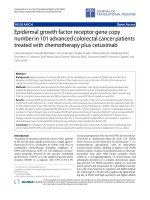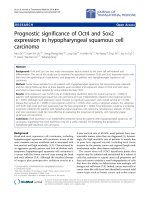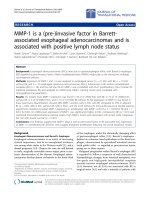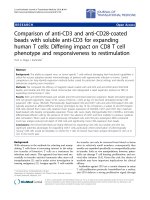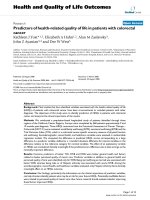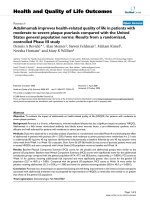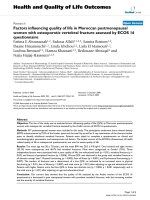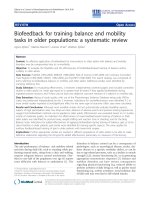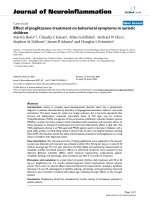báo cáo hóa học:" Factors associated with psychological and behavioral functioning in people with type 2 diabetes living in France" pptx
Bạn đang xem bản rút gọn của tài liệu. Xem và tải ngay bản đầy đủ của tài liệu tại đây (262.11 KB, 8 trang )
RESEARC H Open Access
Factors associated with psychological and
behavioral functioning in people with type 2
diabetes living in France
Stephanie Boini
1,2*
, Marie-Line Erpelding
1
, Anne Fagot-Campagna
3
, Mounir Mesbah
4
, Judith Chwalow
5
,
Alfred Penfornis
6,7
, Vincent Coliche
7
, Etienne Mollet
7
, Keith Meadows
8
, Serge Briançon
1,2
Abstract
Background: To identify demographic and clinical factors associated with psychological and behavioral
functioning (PBF) in people with type 2 diabetes living in France.
Methods: In March 2002, approximately 10,000 adults, who had been reimbursed for at least one hypoglycemic
treatment or insulin dose during the last quarter of 2001, received a que stionnaire about their health status and
PBF (3,646 responders). For this analysis, the 3,090 persons with type 2 diabetes, aged 18-85 years old were
selected.
PBF was measured with the adapted version of the Diabetes Health Profile for people with type 2 diabetes. This
permitted the calculation of three functional scores - psychological distress (PD), barriers to activity (BA), and
disinhibited eating (DE) - from 0 (worst) to 100 (best).
Results: Major negative associations were observed with PBF for microvascular complications (a difference of 6.7 in
the BA score between persons with and without microvascular complications) and severe hypoglycemia (difference
of 7.9 in the BA score), insulin treatment (-8.5 & -9.5 in the PD & BA scores respectively, as compared to treatment
with oral hypoglycemic agents), non-adherence to treatment (-12.3 in the DE score for persons forgetting their
weekly treatment), increasing weight (-8.5 & -9.7 in the PD & DE scores respectively, as compared to stable weight),
at least one psychiatrist visit in 2001 (-8.9 in the DE score), and universal medical insurance coverage (-7.9 in the
PD score) (due to low income).
Conclusion: Prevention and management of microvascular complications or adherence to treatment (modifiable
factors) could be essential to preserving or improving PBF among people with type 2 diabetes. A specific approach
to type 2 diabetes management may be required in groups with a low socioeconomic profil e (particularly people
with universal medical insurance coverage), or other non modifiable factors.
Background
At least 33 million people in European countries had
diabetes in 2000. This number will be multiplied by 1.5
and will reach 48 million by 2030. A similar trend is
observed in France [1]. The prevalence of diabetes is
esti mated at 3.95% and the yearly increase of the preva-
lence is at 5.7%. Six percent of mortality is related to
diabetes and 5% of the resources of the health care
sys tem are used by people with diabetes [2]. Diabetes is
a “fraught with consequences” chronic disease due to its
life-threatening complications and reduced life expec-
tancy. It may develop from a n on-symptomatic disease,
during which patients must adhere to bothersome and
difficult therapy, to a far advanced one, with serious
micro- and macro-vascular complications. Diabetes
negatively affects physical (development of short- and
long-tem complications, symptoms) [3], psychological
(depressed mood, fatigue, frustration, anxiety) [4,5] and
social (change in the quantity and the quality of patients
relationships) functioning [6]. Medical care, while not
* Correspondence:
1
Clinical Epidemiology and Evaluation, CIC-EC CIE6 Inserm, Univ ersity
hospital of Nancy, France
Full list of author information is available at the end of the article
Boini et al. Health and Quality of Life Outcomes 2010, 8:124
/>© 2010 Boini et al; licensee BioMed Central Ltd. This is an Open Access article distributed under the terms o f th e Cr eative Co mmons
Attribution License ( which permits unrestricte d use, distribution, and reproduction in
any medium, provided the original work is properly cited .
able to cure most chronic diseases, can limit their
impact on a patient’s daily life. Diabetes is a typical
chronic disease that places a burden on the person’s
daily activities. Considering the patient ’s point of view is
thus essential in the care and treatment of diabetes.
To this end, b oth generic as well as diabetes specific
health-related quality of life (HRQoL) instruments were
developed. Studies focusing on correlates of HRQoL in
people with diabetes have underlined the importance of
complications [7-9] and depression [10-13].
In France, in 2001, however, there were few data con-
cerning the frequency of diabetes specific co mplications,
prevention and treatment of these complicatio ns, and
even less concerning patient perceptions about diabetes
as a condition and its treatment. For this reason, the
Institute for Health Surveillance, the major national
health insurance system in France and the National
Association for Diabetes Networks Coordination
initiated a large study named ENTRED [14], which
included information about diabetes-rel ated psychologi-
cal and behavioral functioning (PBF).
The aims of this study were to measure psychological
and behavioral functioning (PBF) levels of people with
type 2 diabetes living in France, and to identify socio-
demographic and clinical factors associated with PBF in
this population.
Methods
Data source and subjects
ThedataanalyzedhereweredrawnfromtheENTRED
study.
ENTRED was designed to characterize, to evaluate and
to monitor the health status and the management of
patients treated for diabetes and living in France.
Briefly, subjects were randomly selected from the
national health insurance system database which covers
about 70% of the French population: 10,000 adults living
in France, who had bee n reimbursed for at least one
hypoglycemic treatment or insulin dose during the last
quarter of 2001, received a mailed questionnaire about
their health status and PBF in March 2002. Thirty six
point five percent (n = 3,646) of the questionnaires were
returned. In addition, data from all medical reimburse-
ments were used to characterize markers of medical
care consumption during the year 2001.
The study was approved by the local Institutional
Review Board (CCTIRS n° 01170) and the “ Comité
National Informatique et Liberté” (CNIL n°901236),
which ensures the confidentiality of all information
collected.
Data collection concerned both people with type 1
and type 2 diabetes . People with oral hypoglycemic
treatment or those for whom diabetes had been diag-
nosed after 45 years of age or for whom diabetes had
been diagnosed before 45 years of age with insulin treat-
ment started at least 2 years after diagnosis, were con-
sidered as people with type 2 diabetes. Ninety one point
two percent of respondents were classified as type 2 and
6.4% as type 1 (2.4% were unclassified due to missing
information or presence of another type of diabetes).
Only people up to 85 years old with type 2 diabetes (n
= 3,090) were taken into account in this analysis. People
with type 1 diabetes (n = 231) were excluded due to
major differences in age as well as PBF [15]. Factors
associat ed with type 1 diab etes are reported elsewhere
[16]. People over age 85 years (n = 66) were excluded
due to the potential lack of validity of their answers.
The sample characteristics are summarized in table 1.
Table 1 Characteristics of people with type 2 diabetes
(n = 3,090)
n (%)
Female 1,405 (45.5%)
Age (mean ± sd) 63.9 ± 10.4
Living alone 780 (25.6%)
Education level
Less than high school 1,611 (60.6%)
High school 802 (30.2%)
University 245 (9.2%)
Missing 432
Current professional activity
Employed 514 (16.8%)
Retired 2,084 (68.0%)
Other 466 (15.2%)
Country of birth
France 2,468 (79.9%)
North Africa 335 (10.8%)
Europe 143 (4.6%)
Other country 144 (4.7%)
Diabetes duration (mean ± sd) 11.2 ± 9.5
0-4 years 868 (29.7%)
5-9 years 575 (19.7%)
10-19 years 866 (29.6%)
20 years and more 615 (21.0%)
Diabetes treatment
Oral hypoglycemic agents 2,565 (83.0%)
Insulin 307 (9.9%)
Insulin & Oral hypoglycemic agents 218 (7.1%)
DIABETES COMPLICATIONS
At least one severe hypoglycemic episode 300 (10.0%)
At least one macrovascular complication
a
589 (19.5%)
At least one microvascular complication
b
341 (11.8%)
ENTRED 2001
a
Presence of myocardial infarction, angina or heart arteries surgery
b
Presence of foot ulcer, amputation, eye vision loss, dialysis or kidney
transplantation
Boini et al. Health and Quality of Life Outcomes 2010, 8:124
/>Page 2 of 8
Data collection
Outcomes of interest: psychological and behavioral
functioning
These were measured using the adapted version of the
Diabetes Health Profiles DHP-1 questionnaire for people
with type 2 diabetes, the DHP-18 [17]. The 18 items
were summed into three subscale scores: psychological
distress -PD (6 items); barriers to activity -BA (7 items);
and disinhibited eating -DE (5 items).
Analyses were performed which support the validity of
the French DHP-18 version: the same 3 dimensions of
the original version were identified, internal consistency
was estimated as good, items-to scale correlations
between items and their own dimension w ere high and
those between items and the 2 other dimensions were
low, floor and ceiling effects were limited and accept-
ability was considered as correct (not shown).
All three dimensions were scored from 0 to 100
(worst to best possible functioning). Scores were calcu-
lated as the mean of item values when more than half
of the items was answe red, and scores were recorde d as
missing elsewhere.
Socio-demographic and clinical characteristics of the
subjects
These data were collected through the mailed question-
naire filled in by p articipants. Socio-demographic vari-
ables included: gender, age, living alone (yes/no),
country of birth (further grouped into France, North
Africa, Europe, Other), educational level (less than high
school, high school, university), current professional
activity (employed/retired/other), universal medical
insurance coverage(yes/no), which, in France, permits
free access to medical care for people with a low socioe-
conomic level.
Diabetes and lifestyle characteristics included: duration
of diabetes and its treatment, self-reported weight and
height which permitted the calculation of body mass
index (BMI), changes in weight ("Currently, do you esti-
mate that your weight is?": decreasing/in creasing/stable),
smoking ("Do you usually smoke?”), alcohol consump-
tion, self-reported high blood pressure ("Has a doctor
ever told you that you had high blood pressure?”)and
high cholesterol ("Has a doc torevertoldyouthatyou
had too much cholesterol?” ), regular physical activity
("Do you regularly practice physical activity at home, at
work or during your leisure time?”), at least one dieti-
cian visit in 2001 (yes/no), weight-loss diet (yes/no).
Health status data about diabetes complications were
used to construct 3 indicators: at least one microvascu-
lar complication ("Have you had foot ulcer”, “ amputa-
tion”, “ eye vision loss?”, “Are you in dialysis or have
you had a kidney transplantation?”); at least one macro-
vascular complication ("Has a doctor told you that you
have had a myocardial infarction, angina?”, “ Have you
had a surgery intervention o n your heart arteries?”); at
least one sever e hypoglycemic e pisode ("Have you had
any severe hypoglycemia, requiring the help of another
person to raise your blood sugar?”) in 2001.
Other variables recorded concerned adherence to
treatment with insulin or oral hypoglycemic agents
(OHAs) ("Do you forget your insulin or tablet?": we ekly/
monthly/less than monthly/never), the number of psy-
chiatrics visits, endocrinology visits or hospitalization
(one day or more), and glycated hemoglobin (HbA1c)
test (analyzed as a dichotomous variable: < 3 vs. ≥3/
year, cut-off defined according to the recommendations
of the national agency of accreditation and evaluation in
health care in 2001).
Medical reimbursements records from the health insurance
system database
The number of general practitioner visits during the
year 2001 and consumption of psychotropic drugs dur-
ing the last quarter of 2001 were extracted from this
database.
Statistical Analysis
All descriptive statistics were presented as means and
standard deviations for continuous variables, and as
absolute and relative frequencies for categorical vari-
ables. DHP-18 scores were presented as means and
standard deviations. Percent of missing scores were also
calculated.
The relationships between each DHP-18 score (out-
come) and each collected factor (i.e. sociodemographics,
lifestyle characteristics, diabetes characteristics and com-
plications from the patient questionnaire; medical care
counsumption from the health insurance system data-
base) were first tested by using analysis of variance ( in
the case of categorical independent variables) or simple
linear regression (in th e case of continuous independ ent
variables). Then for each DHP-18 score, all significant
factors were introduced in a multi-factor analysis of var-
iance model and were removed from the final model
when they were no longer associated with the c onsid-
ered DHP-18 score (backward selection).
The statistical threshold for significance was set at
0.05.
These three final multi-factor models were systemati-
cally adjusted for gender and age. Moreover, interactions
between all significant factors and age and gender were
tested for each model.
Statistical analysis was performed using SAS
(r)
9.1 sys-
tem software.
Results
The mean scores of the three DHP-18 dimensions were:
76.8 ± 18.0 for the BA dimension, 66.4 ± 23.9 for the
DE dimension and 80.5 ± 18.8 for the PD dimension.
Boini et al. Health and Quality of Life Outcomes 2010, 8:124
/>Page 3 of 8
Percents of missing scores were lower than 10% (6.2%,
6.6% and 2.5% for the BA, DE and PD dimensio ns,
respectively). Percents of missing raw items of the PD
dimension were always under 5%; those of the BA and
DE dimensions were around 7%.
Factors associated with psychological and behavioral
functioning
All sociodemographic, lifest yle, medical and clinical fac-
tors collected were significantly related to the one or the
other of the 3 dimensions, except the tobacco status
(not shown). The results of the multi-factor analyses are
presented in table 2.
Thirteen factors were statistically associated with the
BA dimension. In particular, patients treated with OHAs
alone presented consistently higher scores on the BA
dimension across all age groups, than patients on insulin
or a combination of insulin and OHAs. This difference
was more pronounced with older patients. Other impor-
tant factors were a severe h ypog lycemic episode during
the previous year (-7.9 in t he mean score as compared
to subjects without severe hypoglycemic episodes; with a
more pronounced negative association in younger peo-
ple) and existing microvascular complication (-6.7), as
well as universal medical insurancecoverage(-5.6),a
lower educational level (-5. 5) and no alcohol consump-
tion (-5.9). All these factors explained 25% of the
variability.
In the PD dimension, 15 factors were related to psy-
chological functioning. The maximal negative associa-
tion with PD dimension was observed for insulin
treatment (-8.5 as compared to treatment with OHAs),
increasing weight (-8.5 as compared to stable weight)
and universal medical insurance coverage (-7.9). The
effect of the other factors was limited to a maximum of
5 point variations. The negative association of a severe
hypoglycemic episode with PD was more pronounced in
younger people. T wenty-one percent of the variability
was explained by these factors.
In the DE dimension, 11 factors were associated with
behavioral functioning. Higher associations were
observed for non-adhe rent patients (-12.3 for patients
who forgot their weekly treatment vs. never), people
with an increasing weight (-9.7 as compared to stable
weight), on a weight-loss diet (-6.3), sedentary peo ple
(-6.3), higher BMI, people who consulted a psychiatrist
at least once in 2001 (-8.7). Overall, 18% of the variabil-
ity was explained by all these factors.
Discussion
Psychological and behavioral functioning was measured
in a large sample of people w ith type 2 diabetes who
werelivinginFrancebyusingascalespecifictodia-
betes. The original DHP-18 is a validated instrument for
use with people with type 2 diabetes [17]. Concerning
the French version, in line with Meadows’ preliminary
results (based on the responses of people with type 1 &
2 diabetes) [18], analyses performed only on people with
type 2 diabetes support its validity. Scores observed in
our sample were close to scores observed in people trea-
ted by insulin, OHAs or diet in previous studies [17,19].
As in our study, insulin therapy was associated with a
marked decrease in psychological functioning.
Many factors were associated with the three DHP-18
dimensions in this sample: some were spec ific to the ill-
ness, some were related to socio-demographic factors,
and some to health-related behavioral factors. The effect
size, a distribution-based indi cator, was calculated to
determine whether a difference could be considered as
important [20]. Accordingly, major negativ e associations
(atleastadifferenceof5betweengroupsintheDHP
score, corresponding here to small to medium effect
size) were observed for major microvascular complica-
tions (effect size of 0.18) -with little or no effect for
macrovascular comp lications- and for severe hypoglyce-
mia (effect size of 0.24), insulin treatment (effect size
from 0.20 to 0.32 according to the DHP score), non-
adhe rence to the treatment (effec t size of 0.45), increas-
ing weight (effect size of 0.18), at least one psychiatrist
visit (effect size of 0.25), and surprisingly no alcohol
consumption (effect size from 0.19 to 0.25 according to
the DHP score). Finally, universal medical insurance
coverage (effect size from 0.20 to 0.46 according to the
DHP score), which, in France, permits free access to
medical care for people with a low socioeconomic level,
was negatively associated with ps ychological functioning,
suggesting a higher toll of diabetes in people with low
socioeconomic level. According to Cohen, effect sizes of
0.2, 0.5 and 0.8 are considered as small, medium and
large, respectively [20]. Therefore, in summary, the
effect on PBF of non-adherence to treatment and uni-
versal medical insurance coverage can be considered as
medium. The effect of insulin treatment, severe hypogly-
cemia, at least one psychiatrist visit and no alcohol con-
sumption can be considered as small.
Our results are in line with those of others studies,
that found a negative impact on HRQoL (especially on
psychological functioning) of the presence of complica-
tions, comorbidities, depressive symptoms, insulin use,
high BMI or a lower educational level [7-9,19,21]. Mad-
dingan et al found that comorbidities (in particular
depression and stroke) and markers of socioeconomic
status were important factors related to HRQoL as mea-
sured by the health utilities index mark 3. To some
extent, a lower educational level, longer diabetes dura-
tion, insulin use, higher BMI and non-practice of physi-
cal activity were also negatively associated with HRQoL
in this study [22]. Others underlined the negative role of
Boini et al. Health and Quality of Life Outcomes 2010, 8:124
/>Page 4 of 8
Table 2 Factors associated with the three DHP-18 scales, in people with type 2 diabetes
Barriers to activity
(N = 2,081)
Psychological distress
(N = 2,113)
Disinhibited eating
(N = 2,312)
beta Se p beta se p beta se p
Intercept 94.99 1.38 < .001 96.64 1.54 < .001 82.27 1.38 < .001
Female 1.29 0.76 0.09 - 4.86 1.80 0.007 - 5.25 1.01 < .001
Age (1 yr) - 0.04 0.05 0.44 0.27 0.04 < .001 0.32 0.05 < .001
Educational level < .001 < .001
Less than high school
- 5.48 1.14 < .001 - 4.80 1.23 < .001
High school - 2.54 1.17 0.03 - 2.26 1.27 0.08
University 0.00 0.00
Country of birth 0.02
Europe - 3.41 1.75 0.05
France 0.00
North Africa - 3.43 1.34 0.01
Other - 0.60 1.72 0.73
Living alone 3.77 0.84 < .001 - 2.61 1.10 0.02
Universal medical insurance coverage
- 5.59 1.76 0.002 - 7.89 1.93 < .001
Diabetes duration (years) 0.04 < .001
0-4 0.00 0.00
5-9 - 1.69 0.94 0.07 - 0.98 1.22 0.42
10-19 - 2.32 0.87 0.008 - 2.16 1.10 0.05
20 and more - 2.37 1.03 0.02 - 2.20 1.28 0.09
Diabetes treatment < .001 < .001 0.10
Insulin
- 9.49 1.23 < .001 - 8.54 1.94 < .001 - 3.35 1.61 0.04
Insulin & OHAs
- 8.79 1.32 < .001 - 2.43 1.97 0.22 - 1.64 1.89 0.39
OHAs 0.00 0.00 0.00
Macrovascular complication
a
- 3.00 0.90 < .001
Microvascular complication
b
- 6.65 1.13 < .001 - 3.33 1.20 0.006
Severe hypoglycemia in 2001
- 7.90 1.19 < .001
Weight-loss diet - 4.10 0.76 < .001
- 6.35 1.03 < .001
At least one dietician visit in 2001 - 2.27 0.82 0.006 - 4.31 0.85 < .001
Perceived weight variation < .001 < .001
Decreasing - 0.81 1.90 0.67 - 1.45 1.39 0.30
Increasing
- 8.46 1.96 < .001 - 9.65 1.42 < .001
Stable 0.00 0.00
Insulin or Tablet forgetting < .001
Weekly
- 12.34 2.39 < .001
Monthly
- 5.96 1.76 < .001
Less than monthly - 4.62 1.41 0.001
Never 0.00
Body Mass Index (1 kg/m²) - 0.51 0.16 0.001
No regular physical activity
c
- 6.25 1.78 < .001
Alcohol consumption < .001 0.03
Daily or almost daily 0.00 . 0.00
Weekly - 0.20 0.92 0.83 - 1.79 1.11 0.11
Monthly - 2.14 1.14 0.06 - 3.95 1.57 0.01
Less than monthly - 1.18 1.16 0.31 - 1.56 1.79 0.39
Never
- 5.86 1.04 < .001 - 5.46 1.66 0.001
High level of cholesterol - 1.77 0.66 0.008 - 2.00 0.71 0.005 - 3.05 0.91 < .001
At least one psychiatrist visit in 2001 - 4.56 1.52 0.003
- 8.71 2.16 < .001
Boini et al. Health and Quality of Life Outcomes 2010, 8:124
/>Page 5 of 8
micro- or/and macro-vascular complications on HRQoL
[6]. Surprisingly, compared to the impact of microvascu-
lar complications, the effe ct of macrovascular complica-
tions was limited (about a 3-decrease only in the BA
dimension). Macrovascular disease was defined in this
study as myocardial infarction or angina, or heart
arteries surgery, and no dis tinction could be performed
between myocardial infarction and angina. Moreover, no
information about the time of occurrence was available.
The presence of both complications was associated with
amoreimportantdecreasethanasingletypeof
complication.
Diabetes complications contribute to excess morbidity
and mortality and generate substantial costs. In order to
provide timely treatment, it is essential that patients at
risk for the development of diabetes complications are
identified as early as possible. The normalization of fac-
tors such as blood pressure, blood cholesterol and
plasma glucose can prevent or delay diabetes complica-
tions [3].
We found a major negative association between the
DE score and having had at least one visit to the psy-
chiatrist in 2001, which might reflect mental health pro-
blems. In particular, depression in diabetes can b e
approached in terms of depressed mood and anhedonia,
cognitive symptoms and anxiety [5]. Depression is a
well-recogn ized determinant of HRQoL in diabetes
[10-12]. Identification and thus optimal care of depres-
sive symptoms is important as depression is associated
with poor diabetes self-management, an increased risk
for complications, a lowed use of health services,
increased functional impairment and distress may well
impact the course of the illness [11,23,24].
Surprisingly, compared to no consumption, daily alco-
hol consumption was associated with better psychologi-
cal functioning (BA and PD dimensions). There i s some
evidence that moderate alcohol consumption is asso-
ciated with a lo wer risk of mortality and coronary heart
disease in people with type 2 diabetes [25]; other studies
suggested a beneficial effect of moderate alcohol
consumption on glycemic control but this has not yet
been demonstrated. Moderate alcohol consumption may
also be a marker of specific psychological profiles.
The most important deficits observed in our study
suggest that prevention and management of modifiable
factors (for example microvascular complications or
adherence to treatment) could be essential to preserving
or improving psychological and behavioral functioning
among people with type 2 diabetes. A sp ecific approach
to type 2 diabetes management may also be required in
groups with a low socioeconomic profile (i.e. people
with a low educational level or for t hose who are on
universal medical insurance coverage) or other non
modifiable factors. Data issue from ENTRED showed
that people with a lower socioeconomic status have
more frequen t macrovascular complications and a lower
quality of diabetes care [26]. Efforts to improve the pre-
vention of complications, therapeutic education and dia-
betes management are required in this vulnerable
population.
Diabetes management is complex and should be
empowered early. To achieve this goal, a multidisciplin-
ary approach is required. Medic al interventions are
needed in order to address a broader spectrum of out-
comes such as patient-reported outcomes (e.g. HRQoL),
personal models of illness and empowerment. The pro-
motion of self-management using strategies that take
into account the adaptation to the illness and its treat-
ment (stress management for self-care of the disease,
psycho-behavioral methods, psychosocial support ) that
are not only limited to drug therapy, should be encour-
age d [27]. Four groups of factors accoun ted for most of
the variability in self-care behavior in patients with dia-
betes: patient characteristics, the patient family, the
practitioner and the health system, and the community/
work setting [28]. Integrating such fact ors in the disease
management can only be beneficial for patients.
There are some limitations in this study. The cross-
sectional design did not allow us to examine any causal
effect. Data were s elf-reported and people could under
Table 2 Factors associated with the three DHP-18 scales, in people with type 2 diabetes (Continued)
Psychotropic substances delivery during the last quarter 2001 - 2.82 0.79 < .001
Other(s) disease(s) - 3.64 0.68 < .001 - 4.06 0.79 < .001 - 4.38 0.92 < .001
R² (%) 25 21 18
ENTRED 2001.
Empty cells mean that factors were not included in the final multivariable model.
Underlining indicates the most important association with the DHP scores.
a
Presence of myocardial infarction, angina or heart arteries surgery;
b
Presence of foot ulcer, amputation, eye vision loss, dialysis or kidney transplantation;
c
House working, do-it-yourself, walking, building/unskilled working, or sport.
Significant interactions were found in the three dimensions:
- barriers to activity: age*other(s) disease(s), p < .0001; age*hypoglycemia, p = 0.006; age*treatment, p < .001;
- psychological distress: Sex*Alcohol consumption, p = 0.05; Age*Hypoglycemic episode, p = 0.01; Age*Treatment, p = 0.008; Diabetes duration*Hypoglycemic
episode, p = 0.002; Diabetes duration*Psychiatrist visit, p = 0.04; Diabetes duration*Weight, p = 0.01; Treatment*Other(s) disease(s), p = 0.008;
- disinhibited eating: Sex*No regular physical activity, p = 0.005; Age*Living alone, p = 0.03; BMI*Diabetes duration, p = 0.004; BMI*Treatment, p = 0.005.
Boini et al. Health and Quality of Life Outcomes 2010, 8:124
/>Page 6 of 8
or over-report any of the collected conditions. However,
when analyzing the same data collected through a medi-
cal questionnaire (sent to the responders’ physician
when its address was reported on the participant’s ques-
tionnaire), Romon et al compared the prevalence of the
macrovascular complication s based on both the patients
and physicians declaratio ns [29]. Estimates were similar
overall, whether they were reported by patients or physi-
cians. Moreover, Martin et al found that self-reports are
reasonably accurate for certain chronic conditions and
for routine screening exams [30]. The algorithm used to
distinguish between res ponders with type 1 and type 2
diabetes may have contributed to some misclassification
of the different types of diabetes. This could affect the
validity of our results if the factors associated with PBF
differed between the two diseases.
External validity of our results is another important
question. People treated with diet only c ould not be
included because the sample selection was based on
thedatabaseofthenationalhealth insurance system,
which covered only reimbursed medical prescriptions.
They may represent about 10% of people with type 2
diabetes [31] and have been reported to show similar
HRQoL as people treated with OHAs [6]. Our sample
showed similar characteristics with other French sam-
ples in terms of age, sex, educational level, BMI, smok-
ing [31-33]. The response rate was about 40%, a level
generally observed in this type of mailing survey. The
characteristics of the responders and the non-respon-
ders were compared using medical claims, available for
all [29]. In our sample, responders were younger and
more often male, more frequently treated with insulin
or with several OHAs than with a single OHAs, less
frequently treated for a cardiovascular disease and
received an overall better quality of diabetes care [29].
Our results may therefore underestimate the true
impact of diabetes on PBF.
Conclusion
Factors associating with PBF were numerous, variable
and sometimes specific to one or the other of the three
dimensions. Particularly, prevention of diabetes micro-
vascular complications and severe hypoglycemic epi-
sodes, as well as improvement of patient adherence,
withaspecialattentiontovulnerable(i.e.withalow
socioeconomic profile) people with type 2 diabetes,
should be sought.
In2006,theFrenchstatelaunchedaspecificplanto
improve HRQoL in people with chronic disease. A bet-
ter understanding of the broader factors associated with
PBF is the first step necessary to permitting the devel-
opment of interventions and policies that will preserve
or improve the daily lives of people with type 2 dia-
betes. Attention to these markers c ould lead to an
improvement in functioning. In 2007, ENTRED will be
repeated in order to measure the possible evolution
since2001.Moreover,theuseoftheSF12,ageneric
instrument will permit a comparison of HRQoL within
the general French population.
Abbreviations
HRQoL: health-related quality of life; PBF: psychological and behavioral
functioning; DHP: diabetes health profile; SF12: short form 12 items
questionnaire; PD: psychological distress; BA: barriers to activity; DE:
disinhibited eating; OHA: oral hypoglycemic agents; HbA1c: glycated
hemoglobin.
Acknowledgements
This study was supported by the national health insurance system via the
“Fond d’aide à la Qualité des Soins en Ville” and by the National Institute for
Health Surveillance.
We especially thank the “Association Nationale de Coordination des Réseaux
Diabète (Ancred)” which designed and conducted the 2001 ENTRED study,
and a French association for diabetic people, the “Association Française des
Diabétiques (AFD)”. We thank all the patients and providers who participated
in the Entred study.
Author details
1
Clinical Epidemiology and Evaluation, CIC-EC CIE6 Inserm, Univ ersity
hospital of Nancy, France.
2
Nancy University, P. Verlaine - Metz University,
Paris - Descartes University, EA 4360 Apemac, Nancy, France.
3
Department of
Chronic Disease and Injury, Institute for Health Surveillance (InVS), Saint-
Maurice, France.
4
Theoretical and Applied Statistics Unit, Pierre & Marie Curie
University - Paris VI, Paris, France.
5
National Federation of the Blind,
Baltimore, USA.
6
Diabetology - Endocrinology - Nutrition - Metabolism,
University Hospital of Besançon, France.
7
National Association for Diabetes
Networks Coordination (ANCRED), Paris, France.
8
DHP Research &
Consultancy Limited, Tower Hamlets PCT, London, UK.
Authors’ contributions
SBo participated in the design of this ancillary work, reviewed the literature
and drafted the manuscript. MLE participated in the design of this work,
performed the statistical analysis, and provided feedback on this work. MM,
JC, AP, VC, EM, and KM provided feedback on this work. JC contributed to
and revised the English version. AFC and SBr participated in the design of
this work and provided feedback on it. All authors collaborated interactively,
read and approved the final version.
Competing interests
The authors declare that they have no competing interests.
Received: 28 December 2009 Accepted: 2 November 2010
Published: 2 November 2010
References
1. Prevalence of Diabetes. [ />2. Numéro spécial consacré au diabète. Editorial. [ />beh/2002/20_21/beh_20_21_2002.pdf].
3. Nazimek-Siewniak B, Moczulski D, Grzeszczak W: Risk of macrovascular and
microvascular complications in Type 2 diabetes: results of longitudinal
study design. J Diabetes Complications 2002, 16:271-276.
4. Polonsky WH: Emotional and quality-of-life aspects of diabetes
management. Curr Diab Rep 2002, 2:153-159.
5. Sultan S, Luminet O, Hartemann A: Cognitive and anxiety symptoms in
screening for clinical depression in diabetes: a systematic examination
of diagnostic performances of the HADS and BDI-SF. J Affect Disord 2010,
123:332-336.
6. Koopmanschap M: Coping with Type II diabetes: the patient’s
perspective. Diabetologia 2002, 45:S18-S22.
7. Wexler DJ, Grant RW, Wittenberg E, Bosch JL, Cagliero E, Delahanty L,
Blais MA, Meigs JB: Correlates of health-related quality of life in type 2
diabetes. Diabetologia 2006, 49:1489-1497.
Boini et al. Health and Quality of Life Outcomes 2010, 8:124
/>Page 7 of 8
8. Davis RE, Morrissey M, Peters JR, Wittrup-Jensen K, Kennedy-Martin T,
Currie CJ: Impact of hypoglycaemia on quality of life and productivity in
type 1 and type 2 diabetes. Curr Med Res Opin 2005, 21:1477-1483.
9. Sundaram M, Kavookjian J, Patrick JH, Miller LA, Madhavan SS, Scott VG:
Quality of life, health status and clinical outcomes in Type 2 diabetes
patients. Qual Life Res 2007, 16:165-177.
10. Goldney RD, Phillips PJ, Fisher LJ, Wilson DH: Diabetes, depression, and
quality of life: a population study. Diabetes Care 2004, 27:1066-1070.
11. Kaholokula JK, Haynes SN, Grandinetti A, Chang HK: Biological,
psychosocial, and sociodemographic variables associated with
depressive symptoms in persons with type 2 diabetes. J Behav Med 2003,
26:435-458.
12. Kohen D, Burgess AP, Catalan J, Lant A: The role of anxiety and
depression in quality of life and symptom reporting in people with
diabetes mellitus. Qual Life Res 1998, 7:197-204.
13. Li C, Ford ES, Zhao G, Balluz LS, Berry JT, Mokdad AH: Undertreatment of
mental health problems in adults with diagnosed diabetes and serious
psychological distress: the behavioral risk factor surveillance system,
2007. Diabetes Care 2010, 33:1061-1064.
14. Entred: lancement d’une étude sur un échantillon national de 10 000
personnes diabétiques traitées. [ />beh_20_21_2002.pdf].
15. Erpelding M, Boini S, Fagot-Campagna A, Mesbah M, Chwalow J,
Penfornis A, Coliche V, Mollet E, Meadows KA, Briançon S: Health related
quality of life reference values (DHP) in people with diabetes living in
France - Entred study, 2001-2003. Bulletin Epidémiologique Hebdomadaire
2009, 34:368-371.
16. Erpelding M, Boini S, Fagot-Campagna A, Mesbah M, Chwalow J,
Penfornis A, Coliche V, Mollet E, Meadows KA: Factors associated with
health-related quality of life in people with type 1 diabetes living in
France. New-Orleans, Louisiana;, 28 October 2009.
17. Meadows KA, Abrams C, Sandbaek A: Adaptation of the Diabetes Health
Profile (DHP-1) for use with patients with Type 2 diabetes mellitus:
psychometric evaluation and cross-cultural comparison. Diabet Med 2000,
17:572-580.
18. An update on the Diabetes Health Profile (DHP-18)-A Short Measure of
Psychological and Behavioural Dysfunctioning in People with Type 1
and Type 2 Diabetes. [ />option=com_content&task=blogcategory&id=20&Itemid=53].
19. de Visser CL, Bilo HJ, Groenier KH, de Visser W, Jong Meyboom-de B: The
influence of cardiovascular disease on quality of life in type 2 diabetics.
Qual Life Res 2002, 11:249-261.
20. Cohen J: Statistical power analysis for the behavioural sciences. Hillsdale
NJ: Lawrence Earlbaum Associates;, 2 1988.
21. Rejeski WJ, Lang W, Neiberg RH, Van Dorsten B, Foster GD, Maciejewski ML,
Rubin R, Williamson DF: Correlates of health-related quality of life in
overweight and obese adults with type 2 diabetes. Obesity (Silver Spring)
2006, 14:870-883.
22. Maddigan SL, Feeny DH, Majumdar SR, Farris KB, Johnson JA:
Understanding the determinants of health for people with type 2
diabetes.
Am J Public Health 2006, 96:1649-1655.
23. Katon WJ, Von Korff M, Lin EH, Simon G, Ludman E, Russo J,
Ciechanowski P, Walker E, Bush T: The Pathways Study: a randomized trial
of collaborative care in patients with diabetes and depression. Arch Gen
Psychiatry 2004, 61:1042-1049.
24. Sultan S, Epel E, Sachon C, Vaillant G, Hartemann-Heurtier A: A longitudinal
study of coping, anxiety and glycemic control in adults with type 1
diabetes. Psychology & Health 2008, 23:73-89.
25. Koppes LL, Dekker JM, Hendriks HF, Bouter LM, Heine RJ: Meta-analysis of
the relationship between alcohol consumption and coronary heart
disease and mortality in type 2 diabetic patients. Diabetologia 2006,
49:648-652.
26. Relations entre caractéristiques socio-économiques et état de santé,
recours aux soins et qualité des soins des personnes diabétiques, Entred
2001. [ />27. Sultan S, Hartemann-Heurtier A, Grimaldi A: [Understanding patients to
promote self-regulation in Type 2 diabetes: how to live with an illness
beginning before its onset?]. Diabetes Metab 2003, 29:S21-S30.
28. Fisher L, Chesla CA, Skaff MM, Gilliss C, Mullan JT, Bartz RJ, Kanter RA,
Lutz CP: The family and disease management in Hispanic and European-
American patients with type 2 diabetes. Diabetes Care 2000, 23:267-272.
29. Romon I, Fosse S, Eschwege E, Simon D, Weill A, Varroud-Vial M,
Detournay B, Fagot-Campagna A: Prevalence of macrovascular
complications and cardiovascular risk factors in people treated for
diabetes and living in France: the ENTRED study 2001. Diabetes Metab
2008, 34:140-147.
30. Martin LM, Leff M, Calonge N, Garrett C, Nelson DE: Validation of self-
reported chronic conditions and health services in a managed care
population. Am J Prev Med 2000, 18:215-218.
31. Detournay B, Cros S, Charbonnel B, Grimaldi A, Liard F, Cogneau J,
Fagnani F, Eschwege E: Managing type 2 diabetes in France: the ECODIA
survey. Diabetes Metab 2000, 26:363-369.
32. Clouet F, Excler-Cavailher G, Christophe B, Masson F, Fasquel D: [Type 2
Diabetes and Short Form 36-items Health Survey]. Diabetes Metab 2001,
27:711-717.
33. Senez B, Felicioli P, Moreau A, Le Goaziou MF: [Quality of life assessment
of type 2 diabetic patients in general medicine]. Presse Med 2004,
33:161-166.
doi:10.1186/1477-7525-8-124
Cite this article as: Boini et al.: Factors associated with psychological
and behavioral functioning in people with type 2 diabetes living in
France. Health and Quality of Life Outcomes 2010 8:124.
Submit your next manuscript to BioMed Central
and take full advantage of:
• Convenient online submission
• Thorough peer review
• No space constraints or color figure charges
• Immediate publication on acceptance
• Inclusion in PubMed, CAS, Scopus and Google Scholar
• Research which is freely available for redistribution
Submit your manuscript at
www.biomedcentral.com/submit
Boini et al. Health and Quality of Life Outcomes 2010, 8:124
/>Page 8 of 8
